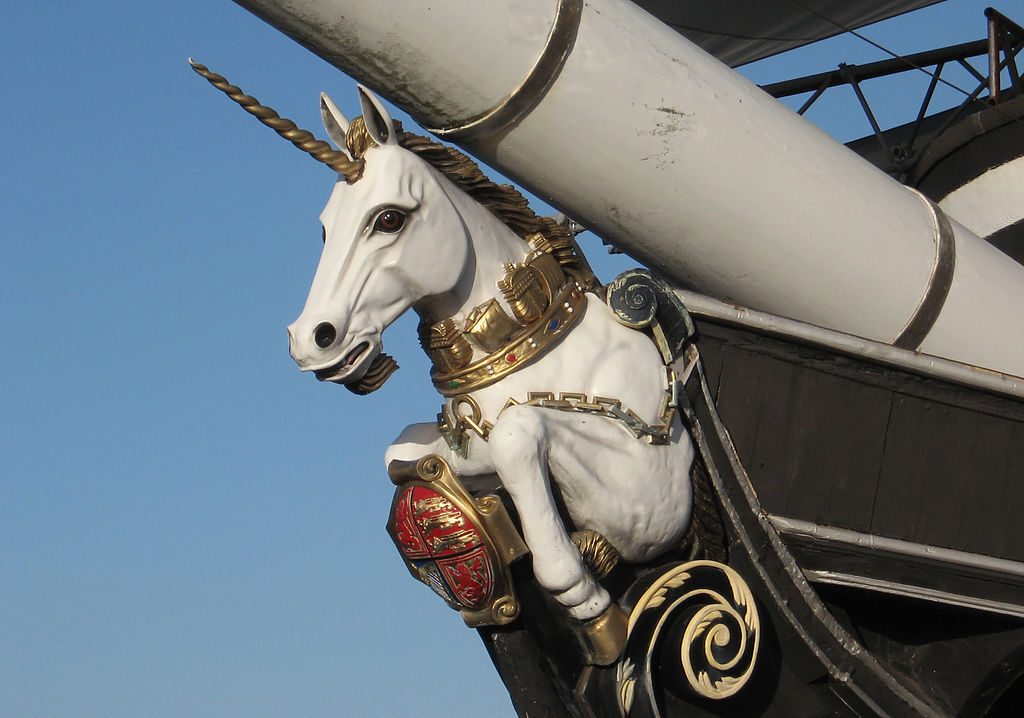Γιατί ο μονόκερος είναι το εθνικό ζώο της Σκωτίας
Although a mythical beast, the unicorn — a white horse-like creature with a lion’s tuft for a tail and a spiraling horn protruding from its forehead — has featured in many cultures as far back as the classical age. Babylonians idolised this enchanting specimen, while peoples from the Indus Valley Civilization incorporated the unicorn into ancient seals. Similarly, unicorns feature in written accounts from the ancient Greeks, Romans and Persians.
Οι Σκωτσέζοι είχαν κάτι για τους μονόκερους πολύ πριν από όλους τους άλλους! Ως εθνικό ζώο της Σκοτίας, αυτό το θρυλικό πλάσμα έχει χρησιμεύσει ως σκωτσέζικο σύμβολο εδώ και αιώνες.
Αν και ένα μυθικό θηρίο, ο μονόκερος – ένα άσπρο άλογο που μοιάζει με κορμό λιονταριού για μια ουρά και ένα σπειροειδές κέρατο που προεξέχει από το μέτωπό του – έχει εμφανιστεί σε πολλές κουλτούρες ήδη από την κλασική εποχή. Οι Βαβυλώνιοι ειδωλοποίησαν αυτό το μαγευτικό δείγμα, ενώ οι λαοί από τον Πολιτισμό της Κοιλάδας του Ινδού ενσωμάτωσαν τον μονόκερο σε αρχαίες σφραγίδες. Ομοίως, οι μονόκεροι παρουσιάζονται σε γραπτές αναφορές από τους αρχαίους Έλληνες, τους Ρωμαίους και τους Πέρσες.

Indus Civilisation Seal Of Unicorn At Indian Museum In Kolkata | © WikiCommons
In Celtic mythology and folklore, unicorns are synonymous with purity, nobility, masculinity, power, courage and an unrivalled sense of strength. They also possess immense healing powers. The legend goes that a unicorn’s horn has the ability to purify waters tainted and poisoned by the surreptitious snake.
Mythology also states that these strong-headed creatures could not be caught unless by virgins, whose purity struck a chord with the equally as pure unicorns until they fell asleep in their laps. Many see this as an allegory for the bond between Christ and the Virgin Mary.
Στην κελτική μυθολογία και λαογραφία, οι μονόκεροι είναι συνώνυμοι της καθαρότητας, της ευγένειας, της αρρενωπότητας, της δύναμης, του θάρρους και της ασυναγώνιστης αίσθησης της δύναμης. Έχουν επίσης τεράστιες θεραπευτικές δυνάμεις. Ο θρύλος λέει ότι το κέρας του μονόκερου έχει την ικανότητα να καθαρίζει τα νερά που είναι μολυσμένα και δηλητηριασμένα από το συγκαλυμμένο φίδι.
Η μυθολογία δηλώνει επίσης ότι αυτά τα πλάσματα με ισχυρή κεφαλή δεν μπορούσαν να πιαστούν παρά από παρθένες, των οποίων η καθαρότητα χτύπησε μια χορδή των μονόκερα μέχρι να κοιμηθούν στην αγκαλιά τους. Πολλοί το βλέπουν αυτό ως αλληγορία για τον δεσμό μεταξύ Χριστού και Παναγίας.

Virgin and Unicorn By Annibale Carracci | © WikiCommons
The unicorn and its sacred bond with Scotland is associated with Scottish heraldry. Praised for its pride and strength, this noble beast featured on an early rendition of a royal Scottish coat of arms by William I in the 12th century. During the 15th and 16th centuries, gold coins were embossed with the unicorn. And so, the Scottish royal coat of arms came to include two unicorns protecting the shield until 1707, when Scotland and England united and a lion was added.
Folklore states that these two creatures were arch enemies in a perpetual state of battle for the title of king of beasts — the unicorn reigned with harmony as power while the lion ruled by valor. Interestingly, even an animal as great and powerful as an elephant, the unicorn’s second arch nemesis, was still no match.
Today, the UK’s royal coat of arms still showcases a unicorn for Scotland and a lion for England. In Scotland, however, the unicorn is accentuated by the addition of a crown and its place on the left-hand side.
Ο μονόκερος και ο ιερός δεσμός του με τη Σκωτία συνδέονται με τη σκωτική εραλδική. Χορηγημένος για την υπερηφάνεια και τη δύναμή του, αυτό το ευγενές θηρίο χαρακτηρίστηκε από μια πρόωρη απόδοση ενός βασιλικού σκωτσέζικου οίκου από τον Γουλιέλμο τον 12 ο αιώνα. Κατά τη διάρκεια του 15ου και του 16ου αιώνα, χρυσά νομίσματα ήταν ανάγλυφα με τον μονόκερο. Έτσι, το σκωτσέζικο βασιλικό οικόσημο ήρθε να περιλαμβάνει δύο μονόκερους που προστατεύουν την ασπίδα μέχρι το 1707, όταν η Σκωτία και η Αγγλία ενώθηκαν και προστέθηκε ένα λιοντάρι .
Η λαϊκή κουλτούρα δηλώνει ότι αυτά τα δύο πλάσματα ήταν εχθροί σε μια διαρκή κατάσταση μάχης για τον τίτλο του βασιλιά των ζώων – ο μονόκερος βασίλευε με αρμονία και δύναμη, ενώ το λιοντάρι κυβερνούσε με ανδρεία.
Σήμερα, το βασιλικό έμβλημα του Ηνωμένου Βασιλείου εξακολουθεί να παρουσιάζει έναν μονόκερο για τη Σκωτία και ένα λιοντάρι για την Αγγλία. Στη Σκωτία, ωστόσο, ο μονόκερος ενισχύεται από την προσθήκη κορώνας και της θέσης της στην αριστερή πλευρά.

Royal Coat Of Arms Used In Scotland | © WikiCommons
Notably, Scottish unicorns are always portrayed with golden chains wrapping over their neck and body. Some liken these to the unicorn’s intense strength, wild temperament and determined will, while others view it as a symbol of Scottish kings.
Συγκεκριμένα, οι σκωτσέζοι μονόκεροι απεικονίζονται πάντα με χρυσές αλυσίδες που τυλίγονται πάνω από το λαιμό και το σώμα τους. Ορισμένοι μοιάζουν με την έντονη δύναμη του μονόκερου, την άγρια ιδιοσυγκρασία και την αποφασισμένη βούληση, ενώ άλλοι το θεωρούν σύμβολο των βασιλέων της Σκωτίας.







Maybe in ancient times, they did exist and then like all extinct animals they have perished too.
LikeLike
Real ‘Siberian unicorn’ remains found
https://edition.cnn.com/2016/03/29/living/real-unicorn-remains/index.html
LikeLiked by 1 person
👍😊
LikeLiked by 1 person
Το δικό μας εθνικό ζώο, μήπως είναι το γαϊδουράκι; χαχαχα! 😛
ΑΦιλάκια και καλή ηλιόλουστη Κυριακή! 🙂
LikeLiked by 1 person
Σημερα ηταν η μερα του μπεμπη μας του Θωμακου !!! Τωρα λοιπον που βρηκα λιγο χρονο να σε ενημερωσω οτι τελικα το εθνικο ζωο της χωρας μας νομιζα πως ηταν η κουκουβαγια αλλα ψαχνοντας ανακαλυψα πως ειναι το δελφινι …..
https://gre.worldtourismgroup.com/did-you-know-that-greece-s-national-animal-is-dolphin-97582
Καλο βραδυ και μια ομορφη Κυριακη για αυριο!!!!!💖💖💖💖💖
LikeLiked by 1 person
Thanks for this. I hadn’t known it
LikeLiked by 1 person
Μy pleasure Derrick!!!!
LikeLiked by 1 person